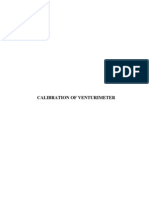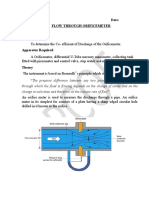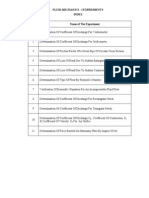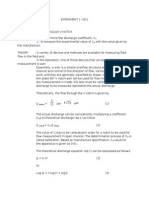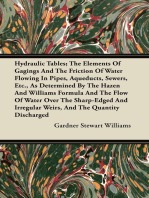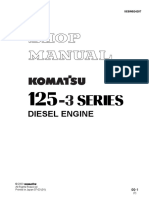1a - ORIFICE METER - 13jan2015 PDF
1a - ORIFICE METER - 13jan2015 PDF
Uploaded by
Partha SurveCopyright:
Available Formats
1a - ORIFICE METER - 13jan2015 PDF
1a - ORIFICE METER - 13jan2015 PDF
Uploaded by
Partha SurveOriginal Title
Copyright
Available Formats
Share this document
Did you find this document useful?
Is this content inappropriate?
Copyright:
Available Formats
1a - ORIFICE METER - 13jan2015 PDF
1a - ORIFICE METER - 13jan2015 PDF
Uploaded by
Partha SurveCopyright:
Available Formats
CALIBRATION OF ORIFICE METER
Orifice meter:
Important length scales:
Inner diameter of pipe, D
= ______ cm
Diameter of orifice,
= ______ cm
d0
Area of collecting tank, A
= ______ ______
Characteristic curves of orifice meter:
= ________ cm2
Calibration of Orifice meter
Exp no: ..
Date : .....
CALIBRATION OF ORIFICE METER
Aim:
i)
ii)
Determine the coefficient of discharge (Cd) of the given orifice meter for different
volumetric flow rates.
Draw the following characteristic graphs
a) Cd Vs Hm
b) Log Qa Vs log Hm
c) Qa Vs Hm
Important length scales:
Inner diameter of pipe
25 mm
Diameter of Orifice
15 mm
Collecting water tank
500 x 500 mm
Apparatus:
Orifice meter, collecting tank, Stop Watch, U-Tube manometer
Theory :
Orifice meter works on Bernoullis principle. It is a device used for measuring the fluid flow rate
through a pipe. It is an economical device for the measurement of flow rate of the medium flowing
through it as compared to venturimeter. An Orifice meter in its simplest form consists of a plate
having a sharp edged circular hole known as an orifice. The plate is fixed inside the pipe in such a way
that the axis of orifice and pipe are aligned. A mercury U-tube manometer is used to measure the
pressure difference across the orifice plate.
Orifice meter works on the same principle as that of Venturimeter i.e. by reducing the area of
flow passage a pressure difference is developed between the two sections and the measurement of
pressure difference is used to find the discharge.
The actual discharge through an orifice meter is given by,
Q a Cd
a 1 .a 0 2 g h
2
cm3/s
(1)
(a 1 a 0 )
Aerospace Engineering Department, IIST
Page 2
Calibration of Orifice meter
Where,
ie,
H m m 1
w
Qa Cd
cm of water
a 1 .a 0 2 g H m m 1
w
cm3/s
(a 1 a 0 )
Hm
difference in levels of mercury in U-tube in cm.
Density of mercury (kg/m3)
Density of water (kg/m3)
Estimation of coefficient of discharge:
Theoretical discharge through Orifice meter is given by,
Q th
a 1 a 0 2gh
2
cm3/s
(2)
(a 1 a 0 )
Where,
a1
Cross section area of pipe at inlet i.e, entry section.
a0
Cross section area of Orifice.
Pressure head difference in terms of fluid flowing through pipeline.
H m m 1
w
level difference of mercury in manometer in cm
Hm
cm of water
Observation Table:
Aerospace Engineering Department, IIST
Page 3
Aerospace Engineering Department, IIST
Sl.
No:
Right
limb
h2
cm
Left limb
h1
cm
cm of Hg
Difference
Hm = h2-h1
Manometer Reading
mean
t
Time for 5 cm rise
in collecting tank
(t)
cm3/s
Qa
Actual
Discharge
cm3/s
Qth
Theoretical
Discharge
Cd
Coefficient of
discharge
log Qa
log Hm
Calibration of Orifice meter
Page 4
Calibration of Orifice meter
Actual discharge through Orifice meter measured from collecting tank,
Q act
V A h
cm3/s
t
t
(3)
Where,
V =
(A x h), volume of water collected in collecting tank in cm3.
A =
Cross section area of collecting tank in cm2.
h =
Height of water collected in collecting tank in cm for a duration of time t
Time required to collect the water up to a height h in the collecting tank.
Hence,
Coefficient of discharge of the orifice meter, cd
Q act
Q th
(4)
The equation (1) can be expressed as,
Q a K H m
Where,
cm3/s
a constant
exponent
(5)
Calibration of orifice meter is to find out the numerical values of K and n.
The equation (5) can be linearized by taking logarithms on both sides.
Q = log K + n log Hm
The graph of the above equation is linear and the values of K and n can be found out from the
measured values of Q and Hm. While plotting the graph by taking log Qa on Y axis and log Hm on X
axis, the slope of the straight line will give the value of n and Y-intercept will give the value of log K.
Plotting a curve Qa Vs Hm , the calibration curve. This enables to find the Qa values directly
corresponding to the manometer reading.
Procedure :
Note the inner diameter at the inlet of pipe (D) and the diameter of an orifice (do).
Note the density of manometer liquid i.e. mercury (m) and that of fluid flowing through
pipeline i.e. water (w).
Connect the U-tube manometer to the pressure tapings of orifice meter, one end at the inlet
section and the other end at the section where jet of water leaves from orifice forming a venacontracta.
Start the flow and adjust the control valve in pipeline to get the required discharge.
Aerospace Engineering Department, IIST
Page 5
Calibration of Orifice meter
Measure the pressure difference (Hm) across the orifice meter by using U-tube mercury
manometer.
Measure flow rate i.e. actual discharge (Qact) through orifice meter by collecting the water in
collecting tank for a specified period of time.
Change the flow rate by adjusting the control valve and repeat the process for at least five
times.
Tabulate the readings and find the values of log Qact and log Hm.
Plot the graph log Qa Vs log Hm.
Determine the value of constant K and n from the graph.
Draw the Calibration Curve by plotting the graph Qa Vs Hm.
Sample Calculations:
Set No _____
Result :
Coefficient of discharge of Orifice,
Cd
The value of
The value of
The Calibration equation is,
Qa
A calibration chart for the given orifice meter is plotted. The curve can be used for determining
discharge corresponding to any manometric head.
Calibration chart :
Sl
No
Hm
Qa
( cm of Hg )
( cm /s )
Inference:
Aerospace Engineering Department, IIST
Page 6
You might also like
- Gasgas Enduro 200-250-300 2T 2018 Workshop ManualDocument72 pagesGasgas Enduro 200-250-300 2T 2018 Workshop ManualAleš ZaverlaNo ratings yet
- DV TOOL HalliburtonDocument15 pagesDV TOOL HalliburtonLarryLevine100% (5)
- Calibration of Venturi MeterDocument9 pagesCalibration of Venturi Meterseminarproject50% (6)
- Thermal Properties of FoodDocument5 pagesThermal Properties of FoodMohamed100% (2)
- Calibration of Triangular NotchDocument8 pagesCalibration of Triangular Notchseminarproject50% (4)
- Fluids Lab Orifice MeterDocument3 pagesFluids Lab Orifice Meterharun_4uNo ratings yet
- Flow Through An OrificeDocument7 pagesFlow Through An OrificeVinay Shenoy100% (1)
- Assignment 1Document1 pageAssignment 1Partha SurveNo ratings yet
- Bend Allowance CalculatorDocument1 pageBend Allowance CalculatorMurtza Arzai100% (1)
- 6789061131.1.6789081867 en-US DM30 II T3 LP - MaintenanceDocument120 pages6789061131.1.6789081867 en-US DM30 II T3 LP - MaintenanceBontor Tua100% (4)
- Calibration of Orifice Meter FinalDocument7 pagesCalibration of Orifice Meter FinalHartono PrayitnoNo ratings yet
- Calibration of Venturimeter FinalDocument7 pagesCalibration of Venturimeter FinalanimeshkumarvermaNo ratings yet
- FM Lab PDFDocument29 pagesFM Lab PDFamitNo ratings yet
- VENTURIMETERDocument4 pagesVENTURIMETERKailash RajuNo ratings yet
- Determination of The Coefficient of Discharge of Given Orifice MeterDocument62 pagesDetermination of The Coefficient of Discharge of Given Orifice MeterPandiya RajanNo ratings yet
- 7b Orifice Plate and VenturimeterDocument6 pages7b Orifice Plate and VenturimeterJAIRAM JaiNo ratings yet
- 3 Notches and Weirs and Losses in Pipe Fittings.Document5 pages3 Notches and Weirs and Losses in Pipe Fittings.JAIRAM JaiNo ratings yet
- 1 Calibrating The Venturi Meter and Orifice MeterDocument5 pages1 Calibrating The Venturi Meter and Orifice MeterRaghavanNo ratings yet
- Experiment No: 5: Measurement of Co-Efficient of Discharge For An Orifice MeterDocument7 pagesExperiment No: 5: Measurement of Co-Efficient of Discharge For An Orifice MeterManoj guptaNo ratings yet
- Ce8381 FMDocument65 pagesCe8381 FMAyyanrajNo ratings yet
- Fallsem2019-20 Che1005 Ela Vl2019201002671 Reference Material Momentum Lab ManualDocument43 pagesFallsem2019-20 Che1005 Ela Vl2019201002671 Reference Material Momentum Lab ManualermiasNo ratings yet
- Calibrating The Venturi Meter and Orifice MeterDocument6 pagesCalibrating The Venturi Meter and Orifice MeterMUTHUKURU VENKATA GOWTHAM REDDY100% (1)
- Experiment 1 - Calibrating The Venturi Meter and Orifice MeterDocument4 pagesExperiment 1 - Calibrating The Venturi Meter and Orifice Meterf20221047No ratings yet
- Fluid Mechanics - I Experiments Index Expt. No. Name of The ExperimentDocument37 pagesFluid Mechanics - I Experiments Index Expt. No. Name of The ExperimentAnand DattNo ratings yet
- Fallsem2021-22 Che1005 Ela Vl2021220101507 Reference Material I 11-Aug-2021 1.flow Through VenturimeterDocument4 pagesFallsem2021-22 Che1005 Ela Vl2021220101507 Reference Material I 11-Aug-2021 1.flow Through Venturimeterkeerthana satheeshNo ratings yet
- Calibration of VenturimeterDocument5 pagesCalibration of VenturimeterRahul KumarNo ratings yet
- Orifice Plate Long ReportDocument16 pagesOrifice Plate Long ReportLuqman HakimNo ratings yet
- Experiment 05: ObjectiveDocument3 pagesExperiment 05: Objectivevj kumarNo ratings yet
- No. Page No.: Name of The ExperimentDocument27 pagesNo. Page No.: Name of The Experimentnitte5768No ratings yet
- III Sem Fluid Mechanics Lab ManualDocument53 pagesIII Sem Fluid Mechanics Lab ManualflorenceprasadNo ratings yet
- Fluid MechanicsDocument14 pagesFluid MechanicsEngr Muhammad Asif JavaidNo ratings yet
- FM Lab ManualDocument21 pagesFM Lab ManualSridhar KanagarajNo ratings yet
- Flow Through An OrificeDocument6 pagesFlow Through An Orificehozipek559950% (2)
- Closed Circuit Venturimeter AimDocument3 pagesClosed Circuit Venturimeter Aimsaggam indureddyNo ratings yet
- Fluid Mechanics Book by RK BansalDocument25 pagesFluid Mechanics Book by RK BansalBibhuti BhusanNo ratings yet
- FM Lab PDFDocument70 pagesFM Lab PDFitsme.namanranjanNo ratings yet
- 5 Calibration of Triangular NotchDocument8 pages5 Calibration of Triangular Notchkanavan monNo ratings yet
- To Determine Coefficient of DischargeDocument7 pagesTo Determine Coefficient of DischargeUmair NawazNo ratings yet
- Ex - No. Flow Through A Rectangular Notch Date: AIMDocument6 pagesEx - No. Flow Through A Rectangular Notch Date: AIMramu117No ratings yet
- Lab Manual of Hydraulics PDFDocument40 pagesLab Manual of Hydraulics PDFJULIUS CESAR G. CADAONo ratings yet
- Experiment No 3 HM LabDocument5 pagesExperiment No 3 HM Labprajwalwanjari5524No ratings yet
- 0 - Notches Apparatus Experiment IMUDocument5 pages0 - Notches Apparatus Experiment IMUAlok KumarNo ratings yet
- VenturiMeter PDFDocument5 pagesVenturiMeter PDFLalalalalalalaalalal100% (1)
- FMMLABDocument35 pagesFMMLABGovind TalawarNo ratings yet
- Venturimeter ExptDocument9 pagesVenturimeter Exptatif irshadNo ratings yet
- Fluid Lab ManualDocument27 pagesFluid Lab ManualvenkiteshksNo ratings yet
- Lab II OrificeDocument6 pagesLab II OrificeGNAAS-KNUST AYMNo ratings yet
- V NotchDocument2 pagesV NotchUstaziyatul AlamNo ratings yet
- 9 05 Experiment 5 Flow Through An Orififce 25 29Document5 pages9 05 Experiment 5 Flow Through An Orififce 25 29IwaNo ratings yet
- V NotchDocument2 pagesV NotchRahul Kumar0% (1)
- Pipe Friction ApparatusDocument6 pagesPipe Friction ApparatusShubham MauryaNo ratings yet
- Venturimeter, Orificemeter & Rotameter Calibration Set-Up: Experiment No. 4Document9 pagesVenturimeter, Orificemeter & Rotameter Calibration Set-Up: Experiment No. 4Somya Maheshwari100% (1)
- Dip - Orifices and Mouth PiecesDocument19 pagesDip - Orifices and Mouth PiecesDan KiswiliNo ratings yet
- Fluid Mechanics Lab Experiment 2Document8 pagesFluid Mechanics Lab Experiment 2SSShakeelNo ratings yet
- TITLE: Venturimeter AIM: To Determine Coefficient of Discharge of Venturimeter. ApparatusDocument8 pagesTITLE: Venturimeter AIM: To Determine Coefficient of Discharge of Venturimeter. Apparatussasha dsilvaNo ratings yet
- Orifice MeterDocument4 pagesOrifice MeterJorah MormontNo ratings yet
- Venturimeter Exp. 250412Document4 pagesVenturimeter Exp. 250412abhishekpatil21No ratings yet
- List of Experiments of Fluid LabDocument24 pagesList of Experiments of Fluid LabGhufran Ahmed0% (1)
- Notches - V and Rect.Document4 pagesNotches - V and Rect.Venkat KrishnaNo ratings yet
- Venturi MeterDocument4 pagesVenturi MeterJorah MormontNo ratings yet
- Flow of Water by Notch and WeirsDocument17 pagesFlow of Water by Notch and WeirsMuhammad Zulhusni Che RazaliNo ratings yet
- NotchesDocument15 pagesNotchesAshwin KhandelwalNo ratings yet
- Southern Marine Engineering Desk Reference: Second Edition Volume IFrom EverandSouthern Marine Engineering Desk Reference: Second Edition Volume INo ratings yet
- Hydraulic Tables; The Elements Of Gagings And The Friction Of Water Flowing In Pipes, Aqueducts, Sewers, Etc., As Determined By The Hazen And Williams Formula And The Flow Of Water Over The Sharp-Edged And Irregular Weirs, And The Quantity DischargedFrom EverandHydraulic Tables; The Elements Of Gagings And The Friction Of Water Flowing In Pipes, Aqueducts, Sewers, Etc., As Determined By The Hazen And Williams Formula And The Flow Of Water Over The Sharp-Edged And Irregular Weirs, And The Quantity DischargedNo ratings yet
- A Treatise on Meteorological Instruments: Explanatory of Their Scientific Principles, Method of Construction, and Practical UtilityFrom EverandA Treatise on Meteorological Instruments: Explanatory of Their Scientific Principles, Method of Construction, and Practical UtilityNo ratings yet
- 1 Sample Calculation - Priy Devvrat Singh - Propeller RPM: 9400 Wind Tunnel RPM: 1000Document2 pages1 Sample Calculation - Priy Devvrat Singh - Propeller RPM: 9400 Wind Tunnel RPM: 1000Partha SurveNo ratings yet
- Z Assignment3 Kundu Cohen SolutionsDocument4 pagesZ Assignment3 Kundu Cohen SolutionsPartha SurveNo ratings yet
- Matlab AssignmentDocument2 pagesMatlab AssignmentPartha SurveNo ratings yet
- 3D-Duct Design Using Variable Fidelity MethodDocument11 pages3D-Duct Design Using Variable Fidelity MethodPartha SurveNo ratings yet
- 14th Finance CommissionDocument6 pages14th Finance CommissionPartha SurveNo ratings yet
- Conclusion 12Document7 pagesConclusion 12Partha SurveNo ratings yet
- Pressure VesselDocument4 pagesPressure VesselPartha SurveNo ratings yet
- AE311 15 Tut 03Document1 pageAE311 15 Tut 03Partha SurveNo ratings yet
- Thermodynamic Work InteractionsDocument4 pagesThermodynamic Work InteractionsPartha SurveNo ratings yet
- AE311 Aerodynamics: (2016-17, Odd Semester) Tutorial - 1Document1 pageAE311 Aerodynamics: (2016-17, Odd Semester) Tutorial - 1Partha SurveNo ratings yet
- Pre Marital Sex ConDocument1 pagePre Marital Sex ConPartha SurveNo ratings yet
- Hty rNHGezaDocument25 pagesHty rNHGezaAudrey NguyenNo ratings yet
- Refrigerant R12 PropertiesDocument1 pageRefrigerant R12 PropertiesFrancesca NettoNo ratings yet
- Mathematical Modeling: ESE439 - Chapter 2Document51 pagesMathematical Modeling: ESE439 - Chapter 2norlelaNo ratings yet
- MR 222 Trafic 1Document152 pagesMR 222 Trafic 1RobertNo ratings yet
- Lab 3 - BucklingDocument6 pagesLab 3 - BucklingAyub BerdanNo ratings yet
- A Study On Effect of Various Process Variables in Gas Metal Arc WeldingDocument8 pagesA Study On Effect of Various Process Variables in Gas Metal Arc WeldingAnonymous lPvvgiQjRNo ratings yet
- Book 1Document4 pagesBook 1Kalpeshkumar PatelNo ratings yet
- Compressors PDFDocument14 pagesCompressors PDFAnonymous lfw4mfCm100% (1)
- Num DiffDocument7 pagesNum DiffMohsan HasanNo ratings yet
- RAZOR MIG 200 ManualDocument40 pagesRAZOR MIG 200 ManualMorallyJustifiedNo ratings yet
- Simplex Basket StrainerDocument42 pagesSimplex Basket StrainerShaisthaNo ratings yet
- Vision 2019 SMKDocument75 pagesVision 2019 SMKTítO-oMítNo ratings yet
- Brake Systems: Railroad Fire Prevention Field GuideDocument12 pagesBrake Systems: Railroad Fire Prevention Field GuideSanthosh S ShettyNo ratings yet
- 11th Physics FB MCQs With KeysDocument29 pages11th Physics FB MCQs With Keyssamyafarooq504No ratings yet
- WPQ 2Document1 pageWPQ 2FirozNo ratings yet
- Performance Analysis of Mixed Flow Pump Impeller Using CFDDocument6 pagesPerformance Analysis of Mixed Flow Pump Impeller Using CFDFauzi AkmalNo ratings yet
- Over Current Relay Working Principle TypesDocument3 pagesOver Current Relay Working Principle TypesSaleem Javed0% (1)
- Eone Generator Gas Dryer (GGD Ii) Justification and Specification InfoDocument6 pagesEone Generator Gas Dryer (GGD Ii) Justification and Specification InfoAmal ChinthakaNo ratings yet
- Diverter GatesDocument3 pagesDiverter GatesBoy Alfredo PangaribuanNo ratings yet
- Global Stability of A Lid-Driven Cavity With Throughflow: Flow Visualization StudiesDocument12 pagesGlobal Stability of A Lid-Driven Cavity With Throughflow: Flow Visualization StudiesDebuNo ratings yet
- Sebm024207 PDFDocument345 pagesSebm024207 PDFanggie100% (3)
- RMPH 2017 PT3 QuestionDocument2 pagesRMPH 2017 PT3 QuestionUguumur TsagaanbayarNo ratings yet
- Lesson-1 CE703 DCSDocument11 pagesLesson-1 CE703 DCSSHAHRIER NAZIM SHUVRONo ratings yet
- Muyang Mixing TechnologyDocument56 pagesMuyang Mixing Technologymarkodzajic100% (2)
- 6-12-0001-Rev5 - General Specification For Pressure VesselsDocument13 pages6-12-0001-Rev5 - General Specification For Pressure VesselsSachinNo ratings yet











